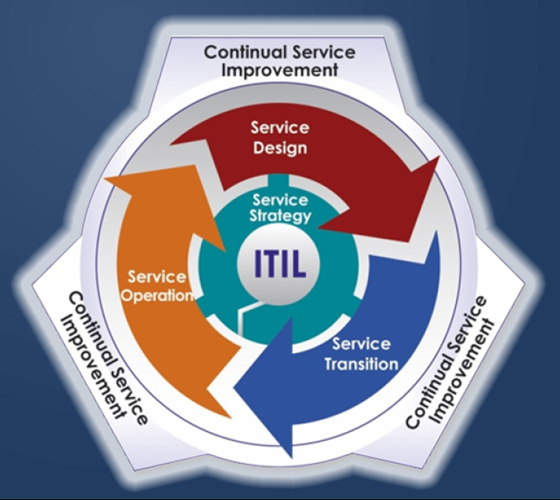
In this post, we cover the ITILv3 service management lifecycle utilizes the Deming cycle. It integrates it into five stages made up of various processes. This will include a discussion of the Deming cycle. The Deming cycle is a cornerstone of the ITILv3 service management lifecycle.
What Does Service Lifecycle Infer?
It is the ever-changing and iterative practice of modifying a service over its life. It does this by integrating new technology and competencies with new enterprise processes. It also incorporates the maintenance, disposition, and removal of service features.
Note: For a refresher see: ITSM vs. ITIL: KEY CONCEPTS OF IT SERVICE MANAGEMENT
ITILv3 Service Management Lifecycle
The ITILv3 processes and most modern ITSM lifecycles use some form of “Plan, Do, Check, Act”. This is also known as the “Deming cycle”. Edwards Deming popularized this model.
ITILv3 service management lifecycle utilizes the Deming cycle. It integrates it into five stages made up of various processes. The intent is for the service provider to check each service. Then they determine whether it is being provided according to the requisite standards. Then they are to take appropriate action when needed.
Note: We will discuss the Deming cycle in more detail in a future post.

Deming Cycle Drives ITSM and ITIL?
Plan, Do, Check, Act is for quality control and continual improvement. The core of Plan, Do, Check, Act is repetition. That means repeating the Plan, Do, Check, Act steps on an ongoing basis. The idea is that repeating this cycle improves your knowledge. At the same time improving the service. By repeating the cycle, you get closer to your goal. The goal being near-perfect outputs from the improved processes.
Stages and Processes of ITILv3 Service Management Lifecycle
The ITILv3 service management lifecycle features a series of five stages or modules. Each stage consists of interactive processes. An example ITILv3 service management lifecycle figure is below. The figure is then trailed by brief descriptions of each lifecycle stage. These descriptions also include the processes, and in some cases, the functions.

1. ITILv3 Service Strategy (SS)
Service Strategy is the first stage of the ITIL v3 service management lifecycle. In this stage, we align the IT service provider's actions with the business it supports. In this stage, the provider will choose a strategy to best serve the business customer. The service strategy is then passed onto the Service Design stage.
Core processes of Service Strategy:
- Strategy Management for IT Services
- Service Portfolio Management
- Financial Management for IT Services
- Demand Management
- Business Relationship Management
Note: Some or all the listed processes have sub-processes. We will discuss those in a future post on Service Strategy.
2. ITILv3 Service Design (SD)
Service Design is the second stage of the ITILv3 service management lifecycle. It is in this stage the design and change of services for the business customers occur. After which they move to the Service Transition stage.
Core processes of Service Design:
- Design Coordination
- Service Catalogue management
- Service Level management
- Capacity management
- Availability management
- IT Service Continuity Management
- Architecture Management
- Compliance Management
- Risk Management
- Supplier Management
- Information Security Management
Note: Some or all the listed processes have sub-processes. We will discuss those in a future post on Service Design.

3. ITILv3 Service Transition (ST)
Service Transition is the third stage of the ITILv3 service management lifecycle. It is where the designed services transition from development to production. After which they go to the Service Operations stage.
Core processes of Service Transition:
- Knowledge Management
- Service Validation and Testing
- Release and Deployment Management
- Service Asset and Configuration Management
- Change Evaluation
- Change management
- Transition Planning and Support (Project Management)
Note: Some or all the listed processes have sub-processes. We will discuss those in a future post on Service Transition.
4. ITILv3 Service Operation (SO)
Service Operations is the fourth stage of the ITILv3 service management lifecycle. This stage provides the services per the agreed-upon service levels. It also helps to resolve the IT challenges faced by users within the core business. Service Operations, unlike the other stages, contains functions, as well as processes. Identified below are some of those functions, along with processes.
Core functions & processes of Service Operations:
- Application Management (Function)
- Facilities Management (Sub-function)
- IT Operations Control (Sub-function)
- IT Operations Management (Function)
- Technical Management (Function)
- Service Desk (Function)
- Access Management
- Problem Management
- Request Fulfillment
- Incident Management
- Event Management.
Note: Some or all the listed functions and processes have sub-functions and sub-processes. We will discuss those in a future post on Service Operations.
5. ITILv3 Continual Service Improvement (CSI)
CSI is the fifth stage of the ITILv3 service management lifecycle. This is where the Deming model comes into its own. Dedication to continual improvement of services is what this stage about. CSI gets applied across all the stages, their processes, sub-processes, functions, and sub-functions. It is continuous throughout the lifecycle and never ends.
Core functions & processes of CSI:
- Monitoring of CSI Initiatives
- Definition of CSI Initiatives
- Process Evaluation
- Service Review
Note: Some or all the listed processes have sub-processes. We will discuss those in a future post on Continual Service Improvement.
Conclusion of ITILv3 Service Management Lifecycle
We welcome any thoughts, disagreements, questions, or comments. Please leave them below. You can also contact us with any questions from our Contact US page.
Congratulations @joebrochin! You have completed the following achievement on the Steem blockchain and have been rewarded with new badge(s) :
You can view your badges on your Steem Board and compare to others on the Steem Ranking
If you no longer want to receive notifications, reply to this comment with the word
STOPTo support your work, I also upvoted your post!
Vote for @Steemitboard as a witness to get one more award and increased upvotes!